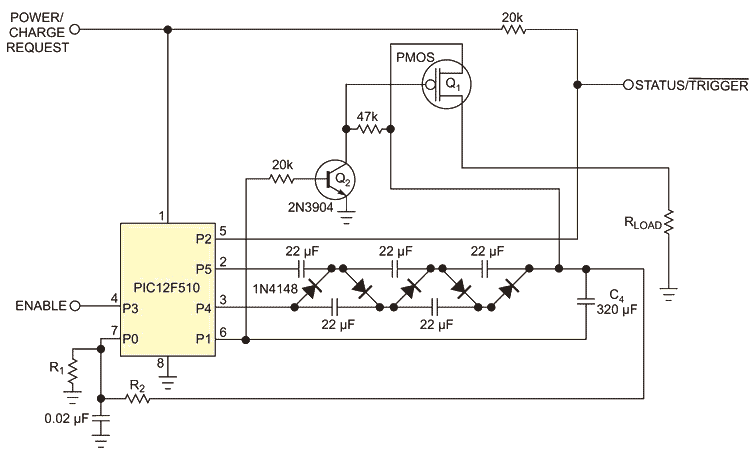An eight-pin micro multiplies, monitors, and delivers a boosted voltage to a load
The circuit in this Design Idea uses a Microchip PIC12F510 controller to drive a voltage multiplier ladder and a single pin to output status and to input a trigger signal you supply (Figure 1). When you trigger the signal, the software turns on a MOSFET to connect the multiplier output to a load. The microcontroller has an internal comparator with a 0.6V trip point. The circuit attenuates and feeds back the output voltage to this comparator.
 |
|
| Figure 1. | This circuit boosts 3V to a regulated 12V and connects the multiplied voltage to a load under software control. |
The controller-based software stops the oscillator, driving the voltage multiplier when the internal comparator indicates that the output voltage has reached an upper limit. This circuit works in a wireless-monitor design, increasing the voltage, power, and range of a small periodic transmitter. It can provide 12 to 15V and 9 to 11 mA.
Processing begins when power is applied. The controller qualifies its Port 3 input on Pin 4. When at a logic high, logic is true, and the software code generates complementary PWM outputs on ports 4 and 5, which are pins 3 and 4, respectively.
These oscillations charge the ladder network. The controller outputs a low on the Port 2/Pin 5 status line, indicating that charging is under way. You choose the ratio of R1 and R2 so that the center node of the ladder is at 0.6V when the output voltage reaches the desired value. When the output reaches the final value, the controller puts the status pin in tristate mode, and the 20-kΩ resistor pulls the pin up to the power-rail voltage. Port 2 on Pin 5 then becomes an input.
When you pull this pin low, the microcontroller asserts Port 1 and Pin 6 high, turning on the P-channel MOSFET through Q2, and applies the output voltage on C4 to the load. Meanwhile, Port 1 and Pin 6 go high, shifting the lower pin of output capacitor C4 from ground to the power rail and adding a few volts to the output of the voltage ladder.
The program drives the complementary outputs at pins 2 and 3 with a 700-μsec PWM period with a 50% duty cycle. You can change the software code to vary these parameters. The controller has an internal 4-MHz oscillator and supports a user-settable reference block. The code continues to monitor the enable pin, C4’s voltage feedback, and the pump operation during the discharge to the load. You must set certain bits in the processor configuration for this code to work:
 |
| Settings |
IKTOSC with 1.125 ms DRT
WDT disabled
Code protection off
GF3/MCLR pin functions as GP3, MCLR internally tied to VDD
4 MHz INTOSC Speed
|
Downloads